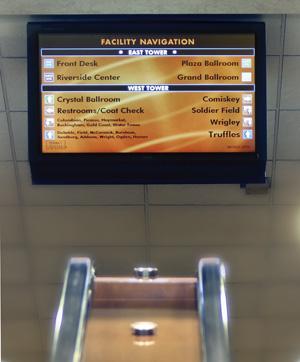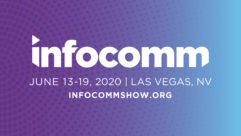

Digital Signage: Opportunity Ahead
By 2011, the digital signage market will be worth $2.59 billion, according to InfoTrends, an analyst firm based in Weymouth, Mass. That’s a lot of opportunity. But in order to feast on the opportunity and not just nibble at crumbs, AV integrators will have to think outside the box?which means selling more than just boxes.
CONTENT IS KING
BY 2011, THE DIGITAL SIGNAGE market will be worth $2.59 billion, according to InfoTrends, an analyst firm based in Weymouth, Mass. That’s a lot of opportunity. But in order to feast on the opportunity and not just nibble at crumbs, AV integrators will have to think outside the box—which means selling more than just boxes.
“If AV dealers aren’t bringing value to customers, they won’t be around long-term,” says Jeff Collard, president of Omnivex, a Concord, Ontario–based maker of software for signage applications. “They can’t go around selling projectors any more.”
What can they do? Understanding the other technologies that go into a modern digital signage application will help shed new light.
One important opportunity is in the area of content creation, which can be a source of both revenue and market differentiation. For example, instead of offering just the displays and installation, integrators can also provide content by adding creative expertise in-house, by partnering with a company like an ad agency, or by reselling prepackaged digital content, such as news, sports, and weather feeds.
“That’s all stuff that can be purchased wholesale and then resold,” says Brad Gleeson, vice president of business development and general manager of CoolSign at Beaverton, Ore.–based Planar Systems. “If you’re getting that content and bringing it into the network for your customer, then you have the opportunity to earn a little margin on that.”
Providing and managing content also means recurring revenue, so the invoices don’t stop once the displays are installed. That after-sale revenue gives the integrator more flexibility when bidding on a job because it lets him compete aggressively on the hardware component knowing any margin losses could be offset later. Offering a one-stop shop of devices and services also allows integrators to go where the opportunities are.
“Integrators and resellers should consider adding services, [such as] installation, consulting, ongoing hosting/management, and content creation,” says Dan Woodward, a senior product manager at Walnut, Calif.–based ViewSonic. “The nondisplay components make up 74 percent of a sale, and all show double-digit growth in projected sales. This includes media players (30 percent), management software (10 percent), and installation (34 percent).”
Some clients want the ability to create and manage their own content instead of farming out the task. Such end-users may still require products and services that integrators can provide. One example is higher education, where campus shootings over the past two years have some schools turning to digital signage as a way to disseminate alerts quickly and widely.
“We are seeing great interest from education: K-12 and community college,” Woodward says. “Education is keen on student communication, [such as in] offices, classrooms, and student unions, and also for emergency notification systems.”
When the signage isn’t displaying emergency alerts, it’s often used for everyday information such as what’s for dinner at each cafeteria. That application highlights another opportunity in digital signage: networking. Using software like Scala’s InfoChannel, a manager at the campus dining department can sit down at a PC, pull up a predesigned template, type in a menu for the day or week, and then schedule it for automatic distribution to every display in every dorm.
“Remote templates are revolutionary in our world,” says Tom Johnson, president of Digital AV, a Fort Wayne, Ind.–based integrator. “It shift some of that content design capability out to direct users.”
Display vendors also are catering to that market with their own content software.
“We have pre-made, vertical-market–oriented template content,” says Planar’s Gleeson. “That allows any of our integrators to [provide] a series of images and dynamic content slides that are easily customized—[such as with] the customer’s corporate logos and colors—and create very professional-looking content.”
Regardless of whose software is used, many vendors and integrators say that clients see centralized control as a way to reduce the cost of updating and distributing content.
“Centrally managing the content is key because they don’t want to have to spend a lot of time updating each screen,” says Bruce Goldstein, senior manager for design and business strategy at Sharp.
Digital Signage: Opportunity Ahead
By 2011, the digital signage market will be worth $2.59 billion, according to InfoTrends, an analyst firm based in Weymouth, Mass. That’s a lot of opportunity. But in order to feast on the opportunity and not just nibble at crumbs, AV integrators will have to think outside the box?which means selling more than just boxes.
INTERACTIVITY SELLSOLD SKILLS, NEW SKILLS
Beyond just content, there are other emerging applications in digital signage that require creativity and technical expertise. Perhaps the most active market for such solutions is retail, where digital signage provides merchants with a way to serve up custom ads based on factors such as what’s in stock and who’s in the store.
Some of these applications are enabled by Radio Frequency Identification (RFID) tags, thumbnail-sized chips that contain information similar to what’s in a Universal Product Code (UPC). Retailers, such as Wal-Mart, use RFID for things like security and inventory tracking, but they also can be used with digital signage.
Digital signage software that delivers content to the same TV that’s showing other programs can be relatively easy for integrators to master and begin offering to clients.
For instance, when a user picks up an RFID-tagged product, the RFID scanner embedded in a nearby display—such as the ADvantage system from Mississauga, Ontario-based BTV+—wirelessly reads that tag and serves up information about that product. Until the cost of RFID tags decreases, retailers typically affix them only to high-value products such as digital cameras and other electronic devices. Coincidentally those products also tend to be semi-complex and could often benefit from a 30-second video highlighting their features.
Other systems use motion-detection cameras and sensors to trigger ads.
When shoppers at Rogers Wireless kiosks pick up a cell phone, they find that it’s tethered to the counter. That’s for security, but it also creates opportunities for interactive digital signage. Adflow Networks created a system where picking up the phone triggers an adjacent display to present information about its features and any promos. The display has a touch screen, so shoppers can pull up additional information, such as available rate plans.
Some digital signage systems use cameras to identify some of the shopper’s demographic information and then serve up a certain ad.
“When somebody comes within 30 to 40 feet of this sign, we can capture enough geometry from that face to know whether it’s a man or woman, approximate age, and how long they spend looking at that sign,” says Planar’s Gleeson. “From that, our software will allow us to trigger an ad specific to that particular audience.”
FROM THE TRENCHES: THE VALUE-ADDED INTEGRATOR
When you develop your own digital signage hardware, you have much more control—and a chance for greater success.
One of my division’s huge technology verticals is digital signage. As you probably know by now, regardless of platform, most signage solutions require edge devices to deliver content. We think there’s an opportunity in those devices to add value.
Whether it’s a solid-state device or an intelligent computer, the signage player is a required component of most systems. Almost all the “top-tier” solution providers use computers, specifically Microsoft Windows XP-based computers, as their player platform.
When it comes to player manufacturers, there two camps—those that provide hardware as part of the solution and those that do not. Those that do provide hardware do it primarily control the technology or to provide turnkey solutions to their dealers. If you ask, most will say they don’t want to be in the hardware business.
The other camp comprises the software-only manufacturers. Some of the biggest names in the industry are in this group. All provide little, if any, hardware as part of their solution. They focus on writing and supporting applications, leaving hardware requirements to the integrator—with their guidance of course. The challenge is building a stable hardware platform on which to build the entire solution. Each manufacturer will provide a hardware recommendation; some will even offer a preferred partner. In the end, it’s up to the integrator to bring it all together and make it work—for the life of the solution.
Our method has been a little different than most. Since we are primarily an IT-centric group, we decided to develop and productize our own player and server platforms. The reason, like that of the first group of manufacturers: to control the edge. Today, our hardware goes into approximately 80 percent of the software-only solutions we deploy. The remaining is either client-defined or client-provided.
In order to succeed, integrators looking to provide digital signage solutions should make serious, educated decisions about hardware platforms. Whether they choose the build-it-or-buy-it path, knowing hardware is a key element. Buying a PC from a store, Internet supplier, or white-box manufacturer may be an option, but you need to know what components make it functional and stable.
The most important component is the graphics card. While most manufacturers will require a DirectX 9-capable card, many offer inadequate performance for playback. And just throwing an expensive gaming card in the computer isn’t the solution, either. Those cards, while powerful, are made to move a lot of small bitmaps around, but aren’t necessarily the right choice for large chunks of graphic manipulations. We’ve found that Matrox (www.matrox.com) makes stable, capable signage hardware, like the new Veos (pictured).
Next is the processor. While most of the time it’s acting as a traffic cop, there are times when it does some serious work. Imagine an MPEG-2 motion background with a Windows Media HD video playing in a window and a real-time RSS weather feed scrolling across the bottom of the screen. In this scenario, the CPU does a lot of work and your average business desktop wasn’t designed to handle such multimedia—more modern Intel Core 2 Duo or even Core 2 Quad processors are a much better choice.
Now, if all of this sounds Greek to you, then don’t provide solutions where you’re responsible for the hardware. But if it’s music to your ears, you’re probably already branching out into new areas. A large portion of what we do is supporting the platforms we sell. If you’re not intimate with the hardware, you’ll be overrun with support issues. Software-only digital signage manufacturers will provide little, if any help—that’s why they don’t do hardware.
—Kris Vollrath Pro AV columnist Kris Vollrath is vice president of Advanced AV in West Chester, Pa., and an industry consultant. He can be reached at [email protected].
A common denominator among these examples is that with the interactive signage creating a self-serve environment, store staff is free to focus on closing sales rather than answering basic questions. The retailer also might be able to reduce staff levels—savings that can help make the business case for deploying interactive signage.
Or they could make the argument that a signage solution can serve additional purposes. At the Rogers Wireless kiosks, sales staff often wound up watching content during slow periods, thereby reinforcing what they learned during their initial training, says Steve Kartonchik, vice president of sales and marketing at Burlington, Ontario-based Adflow Networks, which worked on the project.
For now, interactive digital signage is the exception rather than the rule, but that’s expected to change as hardware costs decline and as more end users see the value.
“They tend to be pricey, so sometimes they’re not rolled into deployments where they could be very beneficial,” says Bill Collins, principal of Decision-Point Media Insights, a Cincinnati-based research firm. “Long term, I think the future for this kind of technology is very, very bright.”
The next type of interactivity could involve video-conferencing. For example, a retailer could reduce staff levels without compromising service if computer shoppers can go to a display and chat with an expert based at the retailer’s head office or someone else related to a product or service.
“You’ll have virtual sales associates, for instance,” Collins says. “There are all kinds of technologies that will make their way into the stores of the future.”
For integrators, those stores will require a mix of old and new skills: videoconferencing and information technology (IT), respectively. Even without next-gen apps, such as virtual sales associates, IT skills are increasingly valuable today for designing and installing systems where content is created at a central location and then disseminated over local- and wide-area networks (LANs and WANs) to signage around a building, campus, or country.
“They can’t add value to that projector, but they sure can add value to how that projector gets integrated into the customer’s business,” says Omnivex’s Collard. “I think that’s where their future lies. You’re seeing so many of them become AV/IT specialists [rather than] a deliverer of boxes.”
IT skills come in handy particularly when a digital signage system needs to communicate with an existing, back-office platform. For instance, a signage network may need to work with a merchant’s inventory or point-of-sale (POS) system to determine which ads to serve. If sales of a particular item are so brisk that inventory runs low, the signage system can stop running ads for that product until supplies are replenished.
“It comes back to measurement and return on investment (ROI): some method to prove that the investment is increasing sales or reducing cost,” Gleeson says.
Integrators that lack the in-house skills to link those systems and configure database queries could partner with IT companies. That way, they still can offer merchants a complete solution rather than, say, just the signage and installation.
Digital Signage: Opportunity Ahead
By 2011, the digital signage market will be worth $2.59 billion, according to InfoTrends, an analyst firm based in Weymouth, Mass. That’s a lot of opportunity. But in order to feast on the opportunity and not just nibble at crumbs, AV integrators will have to think outside the box?which means selling more than just boxes.
HEARING IS BELIEVINGON THE BUBBLE?
Some opportunities in digital signage play directly to AV installers’ existing expertise. Almost by definition, digital signage has to date been a visual experience, but strategic audio is gaining traction, sometimes to create a multimedia effect and sometimes because audio is the best way to present certain types of information.
“The audio component definitely is growing in terms of interest,” says Adflow’s Kartonchik.
OfficeMax has digital signage with directional sound in areas where customers queue to pick up print orders. Besides providing information about OfficeMax services, the signage also plays a CNN feed.
Omnivex’s new Moxie platform and other digital signage programs have made giant leaps in ease-of-use. Such Windows-based software makes it possible for less tech-savvy pros to not only build rich content, but also better manage signage networks.
“That decreases the perceived wait time,” says Kartonchik, whose company worked on the project.
One common issue is how the digital signage audio interacts with the rest of the store environment. For example, when conventional loudspeakers are paired with digital signage in areas where store staff spend much of their day—such as a checkout line—hearing the same content over and over can prompt them to turn off the audio, making the content less effective.
The alternative is to use directional loudspeakers, including a type known as parametrics, which create a narrow beam of sound that disappears if the person moves just a few feet out of the sweet spot. Digital signage with parametric speakers can be a good fit for a variety of environments, such as a store where conventional loudspeakers would compete with one another.
Another alternative is to pair the loudspeakers—regardless of whether they’re directional or not—with sensors that detect the store’s ambient sound level and automatically adjust the volume.
Some digital signage opportunities take a while to materialize—not because the technology isn’t mature, but rather because certain vertical markets have long lead times.
“Most of my projects involve a corporation or a university determining that they need digital signage, and then they begin the process—which could take up to two or three years—of the best way to do it,” says Digital AV’s Johnson. He often gives them a request for proposal (RFP) template, which helps guide them. “It makes it easy for them.”
Adflow Networks is among the vendors currently seeing more interest than installs.
“It seems as if there are a lot of organizations out there talking about it and planning for it, but they haven’t done anything yet,” Kartonchik says. “I think we’re looking at a bubble somewhere in the next 18 months where suddenly it’s going to go boom, and people will be scrambling to try to get something implemented. But we’re not there yet.”
Tim Kridel is a freelance writer and analyst who covers telecom and technology. He’s based in Columbia, Mo. He can be reached at [email protected].










